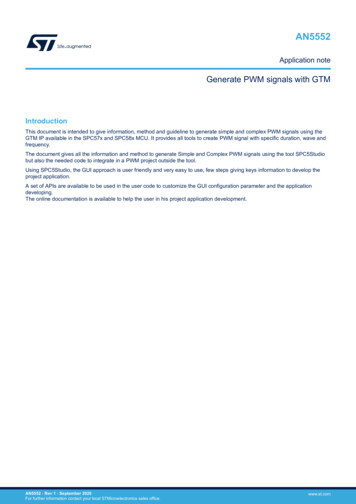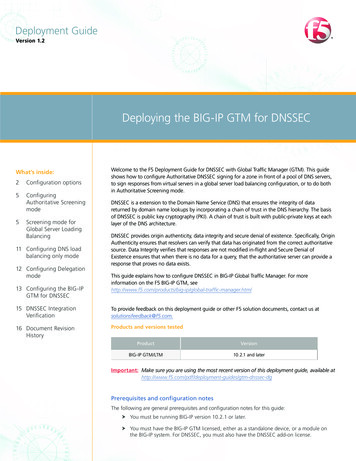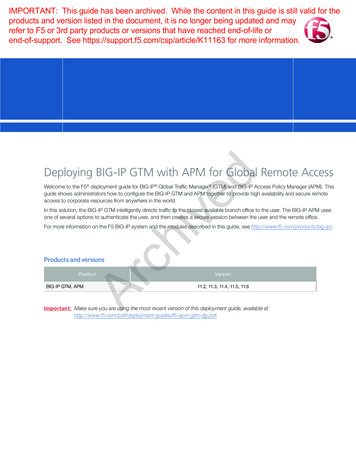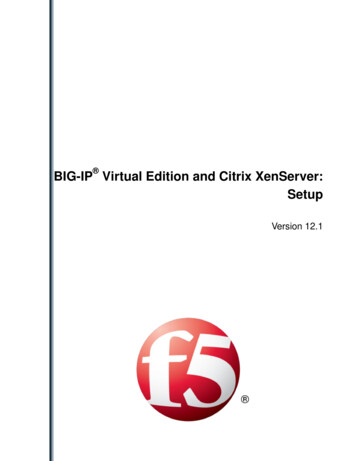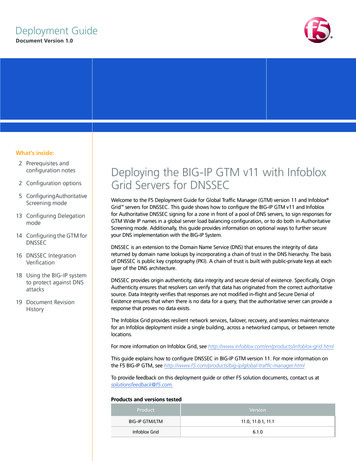
Transcription
Deployment GuideDocument Version 1.0What’s inside:2 Prerequisites andconfiguration notes2 Configuration options5 Configuring AuthoritativeScreening mode13 Configuring Delegationmode14 Configuring the GTM forDNSSEC16 DNSSEC IntegrationVerification18 Using the BIG-IP systemto protect against DNSattacks19 Document RevisionHistoryDeploying the BIG-IP GTM v11 with InfobloxGrid Servers for DNSSECWelcome to the F5 Deployment Guide for Global Traffic Manager (GTM) version 11 and Infoblox Grid servers for DNSSEC. This guide shows how to configure the BIG-IP GTM v11 and Infobloxfor Authoritative DNSSEC signing for a zone in front of a pool of DNS servers, to sign responses forGTM Wide IP names in a global server load balancing configuration, or to do both in AuthoritativeScreening mode. Additionally, this guide provides information on optional ways to further secureyour DNS implementation with the BIG-IP System.DNSSEC is an extension to the Domain Name Service (DNS) that ensures the integrity of datareturned by domain name lookups by incorporating a chain of trust in the DNS hierarchy. The basisof DNSSEC is public key cryptography (PKI). A chain of trust is built with public-private keys at eachlayer of the DNS architecture.DNSSEC provides origin authenticity, data integrity and secure denial of existence. Specifically, OriginAuthenticity ensures that resolvers can verify that data has originated from the correct authoritativesource. Data Integrity verifies that responses are not modified in-flight and Secure Denial ofExistence ensures that when there is no data for a query, that the authoritative server can provide aresponse that proves no data exists.The Infoblox Grid provides resilient network services, failover, recovery, and seamless maintenancefor an Infoblox deployment inside a single building, across a networked campus, or between remotelocations.For more information on Infoblox Grid, see htmlThis guide explains how to configure DNSSEC in BIG-IP GTM version 11. For more information onthe F5 BIG-IP GTM, see anager.htmlTo provide feedback on this deployment guide or other F5 solution documents, contact us atsolutionsfeedback@f5.com.Products and versions testedProductVersionBIG-IP GTM/LTM11.0, 11.0.1, 11.1Infoblox Grid6.1.0
DEPLOYMENT GUIDEInfoblox and GTM for DNSSECImportant: M ake sure you are using the most recent version of this deployment guide, availableat tm-dnssec-dgPrerequisites and configuration notesThe following are general prerequisites and configuration notes for this guide:hh Y ou must be running BIG-IP version 11.0 or a later version in the 11.x series.If you are running BIG-IP version 10.2.x, oblox-dnssec-dg.pdf.hh Y ou must have the BIG-IP GTM licensed, either as a standalone device, or a module onthe BIG-IP system. For DNSSEC, you must also have the DNSSEC add-on license.hh Your Infoblox appliances must already be licensed and configured as a Grid.hh T he Infoblox Grid member servers running the DNS service should be on version 6.1.0or later.hh W hile not required for this configuration, we also strongly recommend using the BIG-IPLocal Traffic Manager (LTM) as described in this document.hh Y ou must have administrative access to both the Web management and SSH commandline interfaces on the BIG-IP system.hh T he BIG-IP system must be initially configured with the proper VLANs and Self IPaddresses. For more information on VLANs and Self IPs, see the BIG-IP documentation.hh You must have administrative control of the DNS zone being protected.hh I f there are firewalls in your infrastructure, you must have TCP port 443 open in bothdirections. TCP port 22 for SSH access to the command line interface is also needed forconfiguration verification.hh F or more configuration options on the BIG-IP GTM, see the Configuration Guide for BIGIP GTM Module, available on Ask F5.hh W e recommend you read the Technical Brief F5 and Infoblox DNS Integrated foblox-wp.pdf) for a configuration overview.hh W e recommend you read the NIST Secure Domain Name System Deployment 00-81r1/sp-800-81r1.pdf). We use the NISTrecommended values in this guide.hh F or information on additional, optional ways to secure your DNS implementation, seeUsing the BIG-IP system to protect against DNS attacks on page 18.Configuration optionsThere are three main ways to configure the BIG-IP GTM system for DNSSEC shown in this guide.The method you choose depends on your configuration and if you are also using the BIG-IP LTM. uthoritative Screening modeAThe Authoritative Screening architecture enables BIG-IP GTM to receive all DNS queries, managingvery high-volume DNS by load balancing requests to a pool of Infoblox Grid servers. Additionally,the Authoritative Screening architecture seamlessly provides all of the benefits of intelligent GSLBservices.When a DNS query is received, the BIG-IP checks the record type. If the type is an A, AAAA, A6,or CNAME request, it is sent to BIG-IP GTM module. The BIG-IP GTM checks each request and2
DEPLOYMENT GUIDEInfoblox and GTM for DNSSECresponse, looking for a match against the Wide IP (WIP) list of FQDN names. If there is a match, theBIG-IP GTM performs the appropriate GSLB functions and return the best IP address appropriate forthe requesting client.If the DNS request does not match the Wide IP list, BIG-IP GTM passes the request to a pool ofDNS servers, which provides an additional layer of scalability and availability, increasing the queryperformance and ensuring optimal uptime of DNS services. Screening mode simplifies managementwhen used with Infoblox DNS servers (see the Technical Brief mentioned above).GTM inspects all DNS responses from the DNS servers. If the response contains a DNS name thatmatches a Wide IP, GTM intercepts the response, applies the GTM operations for that item, andre-writes the response before sending it on to the client.ClientClientClient1243BIG-IPGlobal Traffic Managerwith DNSSECexample.comFigure 1: Authoritative screening mode with DNS load balancingThe following describes the traffic flow for Authoritative Screening:1. The client, via LDNS, requests the MX record for example.com.2.The BIG-IP GTM asks the Infoblox Grid server pool for the MX record3.T he Infoblox server responds to the MX record request with the CNAME mail.example.comand an A record with an IP address.4.T he BIG-IP GTM matches a wide IP for mail.example.com. The GTM responds to the clientrequest with mail.example.com and rewrites the IP address of the mail server. GTM adds theDNSSEC signature.DNS Load BalancingYou can use F5’s DNSSEC to sign screened responses from 3rd party DNS servers as well asresponses from the BIG-IP GTM, saving time and effort by automating DNSSEC configuration.DelegationDelegation has been the traditional deployment method. This solution involves delegating aspecific subzone that contains all the GSLB elements of the DNS architecture. In this scenario, aCNAME is used to redirect other names to one located in the delegated subzone. One drawbackwith delegation mode is that the administrator is required to create a CNAME for all related DNSrecords.3
DEPLOYMENT GUIDEInfoblox and GTM for DNSSECIn this example, the DNS servers completely manage the top-level zone (such as example.com).The NS records point to the names and, indirectly, the IP address of the DNS servers. BIG-IP GTM isauthoritative for a subzone and handles all queries to that zone (for instance, gtm.example.com).All GSLB resources are represented by A-records in the GTM zone. A BIND name server runningon BIG-IP GTM contains the subzone records. Host names in the top-level zone are referred to theGTM-controlled subzone using CNAME alias records. CNAME references can be from almost anyother zone, including the subzone. More than one subzone can be delegated to and managed byGTM zone.ClientClient1Client34BIG-IPGlobal Traffic Managerwith DNSSEC2example.comFigure 2:Delegation modeThe following describes the traffic flow for delegation:41.Client requests www.example.com.2.T he DNS server that owns www.example.com returns a CNAME for www.example.com towww.gtm.example.com.3.The local DNS requests www.gtm.example.com.4.T he BIG-IP GTM has the wide IP and owns the gtm subzone. The GTM handles DNSSEC forthe subzone only. The GTM responds with the best IP address based on the load balancingconfiguration for the pool.
DEPLOYMENT GUIDEInfoblox and GTM for DNSSECConfiguring Authoritative Screening modeIn this section, we configure the Infoblox appliances and the BIG-IP GTM for AuthoritativeScreening mode. Some of the procedures in this section depend on whether you are using a BIG-IPLTM in front the pool of servers.Configuring the Infoblox appliances for Authoritative Screening modeThe following list provides guidance on configuring the Infoblox appliances for use with the BIG-IPGTM in Authoritative Screening mode. On the Infoblox appliances, you enable DNSSEC and createa zone, as well as creating MX and A records to be matched by the GTM Wide IP.ImportantAlthough all responses are signed only by the BIG-IP, you must configure the Infoblox appliances toallow DNSSEC information to be added to them. Do NOT configure Infoblox to sign any zones.For specific instructions on configuring Infoblox devices, see the Infoblox documentation.hh S tart DNS services on GridGrid-- Services-- DNS-- select Grid members-- Starthh Enable DNSSECGrid-- Members-- Grid Properties-- DNSSEC-- Enable (do NOT sign any zones)hh C reate a zoneData Management-- DNS-- Zones-- Add-- Authoritative Forward Mapping Zone-- Zone Name (match DNSSEC zone name in GTM)-- Use This Set of Name Servers-- Add-- Add Grid Primary and Secondary servers to Zone-- Save and Closehh C reate a MX recordData Management-- DNS-- Zone-- Add-- Record-- MX-- Fill out Mail Destination andMail Exchanger (record to be matched by GTM Wide IP, e.g. mail.iblox.example.com)»» C reate an additional A record for the mail exchanger name (to be rewritten byGTM, e.g. mail.iblox.example.com) and uncheck the Minimal Response setting (DataManagement-- DNS Members-- Select check box (one at a time)-- click the Editicon-- uncheck “Return minimal responses”).)This completes the Infoblox configuration.Configuring the BIG-IP GTM in Screening mode for GSLBUse the following procedures to configuring Screening mode for Global Server Load Balancing.Creating the DNS profileThe first task is to create a DNS profile. The DNS profile has a number of options that you can setdepending on how you are configuring the BIG-IP GTM. Use the table in the following procedureto configure the DNS profile according to your implementation.To create the DNS profile51. On the Main tab of the navigation pane, expand Local Traffic and then click Profiles.2.On the Menu bar, from the Services menu, click DNS.3.Click the Create button. The new DNS Profile screen opens.
DEPLOYMENT GUIDEInfoblox and GTM for DNSSEC4. se the following table to configure the DNS profile options. The Setting column contains theUrequired settings for this configuration. If there are two options, use the one applicable foryour implementation.Option15.DescriptionSettingGlobal TrafficManagementEnables Global Server Load Balancing (GTM)functions. Needed for Wide IPs to match DNStrafficEnabledDNS IPv6 to IPv4Enables translation of IPv6 addresses to IPv4.DisabledDNS ExpressEnables the BIG-IP to function as a DNS slaveserver for accelerating responses and securingDNS servers.DisabledDNSSECEnables DNSSEC signing of responses.EnabledUnhandled QueryActionsDetermines how the BIG-IP system shouldprocess queries not matching a record in GTMor DNS Express.If not using DNS Load Balancing: DropIf using DNS Load Balancing: AllowUse BIND Server onBIG-IPEnables BIND server on the BIG-IP system.Should always be Disabled.DisabledRecursion DesiredEnables the BIG-IP system to query other DNSservers to resolve a name. When using theBIG-IP as an authoritative DNS server, thisshould be disabled; all queries with therecursion bit set are dropped immediately.If configuring BIG-IP as an authoritativeDNS Server: DisabledOtherwise1: EnabledFor example, if configuring the BIG-IP as a DNS server resolving internal client queries for external recordsClick the Finished button.Creating GTM ListenersThe next task is to create a Listener on the BIG-IP GTM. A listener is an object that monitors thenetwork for DNS queries. For a complete GTM configuration, you need four DNS listeners: IPv4TCP, IPv4 UDP, IPv6 TCP, and IPv6 UDP.To create a Listener1. n the Main tab of the navigation pane, expand Global Traffic and then click Listeners.OThe main Listeners screen opens.2.Click the Create button. The new Listener screen opens.3. In the Destination box, type the IP address on which the Global Traffic Manager listens fornetwork traffic. In our example, this is the Self IP address of the GTM on the internal VLAN.Important Be sure to use a Self IP address and not the Management address of the BIG-IP GTM.64.From the VLAN Traffic list, select a VLAN setting appropriate for this listener.5.From the DNS Profile list, select the DNS profile you created.6.Click the Finished button.7. epeat to create additional listeners. If creating an IPv6 listener, be sure to use an IPv6 addressRas the destination.
DEPLOYMENT GUIDEInfoblox and GTM for DNSSECCreating the GTM Data CenterThe next task is to create a new GTM Data Center that corresponds to your physical data center.To create the data center1. On the Main tab, expand Global Traffic and then click Data Centers.2.Click the Create button. The New Data Center screen opens.3. In the Name box, type a name for this data center. In our example, we typeLocal Datacenter.4.Complete the rest of the configuration as applicable for your deployment.5.Click the Finished button.Creating the GTM Server objectsNext, we create the GTM Servers. A server defines a specific system on the network.The steps in this procedure are slightly different if you are using a standalone GTM device orthe GTM module in combination with a BIG-IP LTM. These differences are clearly marked in thefollowing procedures.ImportantYou must add a Server object for the BIG-IP GTM you are currently configuring and every GTM thatis a part of the sync group. For more information on GTM sync groups, see the online help or GTMdocumentation.To create the GTM servers1. On the Main tab, expand Global Traffic and then click Servers.2.Click the Create button. The New Server screen opens.3. In the Name box, type a name that identifies this GTM. In our example, we type GTM-1.4. From the Product list, select the either BIG-IP System (Single) or BIG-IP System(Redundant).NoteRedundant is only used when the GTM is also an LTM/GTM combo and specifically configuredfor LTM failover of the listener. Otherwise use BIG-IP System (Single).5.Important In the Address List section, type the self IP of this GTM, and then click the Add button.Be sure to use a Self IP address and not the Management address of the BIG-IP GTM.If you selected BIG-IP System (Redundant) in step 4, type the appropriate IP address in thePeer Address List section.6. From the Data Center list, select the Data Center you created in Creating the GTM DataCenter on page 7. In our example, we select Local Datacenter.7. Optional: In the Health Monitors section, from the Available list, select the monitor typebigip and then click the Add ( ) button.8. From the Virtual Server Discovery list, perform the following depending on whether youare using a third party load balancer, or a remote BIG-IP LTM:9.7 Third Party Load Balancer: Leave Discovery set to Disabled. TM Module: From the Discovery list, select Enabled. (We strongly recommend EnablingGDiscovery, however you can leave this set to Disabled and manually configure the virtualserver information).Click Finished.
DEPLOYMENT GUIDEInfoblox and GTM for DNSSEC10. The next step depends on your configuration: I f you have additional BIG-IP GTMs in your implementation, repeat this procedure to addthem. I f you are using the GTM and LTM on the same box, continue with the next section.However, if there are external BIG-IP LTM devices that are a part of the configuration, youmust add a GTM Server object for those as well. Repeat this procedure for each externalLTM. I f you are using a GTM standalone, repeat this procedure to create the GTM Serverobjects for each of the load balancers (a BIG-LTM in our example) and continue with step10.Enabling connectivity with remote BIG-IP systemsIf you are adding a remote BIG-IP LTM server, you must make sure big3d agent on the sameversion on the BIG-IP LTM and GTM.ImportantThis is only necessary if you are using remote LTM devices.From the GTM device command line, typebig3d install IP address of target system where the target system is the LTM that you want to add as a server on the GTM. This pushes outthe newest version of big3d.Next, typebigip addto exchange SSL keys with the LTM. Type the password at the prompt, and then typeiqdump ip address of remote box .If the boxes are communicating over iQuery, you see a list of configuration information from theremote BIG-IP.The bigip add command must be run for every BIG-IP in the configuration.Adding GTM servers to a Sync GroupYou must run gtm add on each additional GTM in the sync group as well to ensure the iQueryconfiguration is working. If not already part of a sync group, this command adds the GTM to thesync group. For more information on sync groups, see the GTM documentation.Creating the GTM health monitorsThe next task is to create the GTM health monitors. If you are using the BIG-IP LTM, status from theLTM monitors will be available in the GTM. The following GTM monitors add an additional layer ofmonitoring that is initiated by the GTM. While health monitors are not technically required, theyare strongly recommended. The monitors shown in the following sections are examples, you canuse other monitor types appropriate to your deployment.To create the TCP and HTTP monitors81.On the Main tab, expand Global Traffic and then click Monitors.2.Click the Create button. The New Monitor screen opens.3. In the Name box, type a name for the monitor. In our example, we typegtm-monitor-tcp.4.From the Type list, select TCP.5.From the Configuration list, select Advanced.
DEPLOYMENT GUIDEInfoblox and GTM for DNSSEC6.Configure any of the other options as applicable for your implementation.7.Click the Repeat button to create another monitor for HTTP.8. In the Name box, type a name for this monitor. In our example we named itgtm-monitor-http.9.From the Type list, select HTTP.10. Configure the other options as applicable for your implementation.11. Click the Finished button.Creating the GTM PoolFirst, we create a pool on the BIG-IP GTM system that includes the virtual servers of load balancingdevice (BIG-IP LTM in our example).To create a GTM pool1. On the Main tab, expand Global Traffic and then click Pools (located under Wide IPs).2.Click the Create button. The New Pool screen opens.3.In the Name box, type a name for the pool. In our example, we type Local pool.4. In the Health Monitors section, from the Available list, select the name of the monitors youcreated in Creating the GTM health monitors on page 8, and then click the Add ( )button after each. In our example, we select gtm-monitor-tcp and gtm-monitor-http.5. In the Load Balancing Method section, choose the load balancing methods from the listsappropriate for your configuration.6. In the Member List section, from the Virtual Server list, select the appropriate virtual serveron the load balancer for the application, and then click the Add button. ote that you must select the virtual server by IP Address and port number combination. InNour example, we select 10.10.11.3:80.Repeat this step for additional virtual servers.7.Configure the other settings as applicable for your deployment8.Click the Finished button.Creating the GTM Wide IPIn this procedure, we create a wide IP that includes the GTM pool you created, and the hostname . In our example, we use www.example.com. GTM attempts to match DNS requestsand responses to the resource indicated by the Wide IP.To create a wide IP91. On the Main tab, expand Global Traffic and then click Wide IPs.2.Click the Create button. The New Wide IP screen opens.3. In the Name box, type a name for the Wide IP. In screening mode, this is the FQDN of thehost. In our example, we type mail.example.com.4.From the State list, ensure that Enabled is selected.5. From the Pools section, from the Load Balancing Method list, select a load balancingmethod appropriate for your configuration.
DEPLOYMENT GUIDEInfoblox and GTM for DNSSEC6. In the Pool List section, from the Pool list, select the name of the pool you created inCreating the GTM Pool on page 9, and then click the Add button. In our example, weselect Local pool.7.All other settings are optional, configure as appropriate for your deployment.8.Click the Finished button.Configuring the GTM for DNSSECIf you are not planning to use DNS load balancing in your configuration as described in thefollowing section, continue to Configuring the BIG-IP GTM for DNSSEC on page 15.ImportantAdding DNS load balancing to Screening mode for GSLBUse the following procedures to add DNS Load Balancing to Screening mode for GSLB.Creating the LTM monitorsIf you are using the BIG-IP LTM, configure the following monitors. These monitors test the serversto ensure the Infoblox Grid server DNS services are operational. DNS is available over UDP andTCP protocols, so we create a health monitor for each protocol over port 53. If you only choose toimplement one monitor, we recommend the UDP monitor.To create the LTM monitors1.On the Main tab, expand Local Traffic and then click Monitors.2.Click the Create button. The New Monitor screen opens.3. In the Name box, type a name for the monitor. In our example, we typeltm-infoblox-monitor-tcp.4.From the Type list, select TCP.5.From the Configuration list, select Advanced.6.In the Alias Service Port box, type 53.7.Configure any of the other options as applicable for your implementation.8.Click the Repeat button to create another monitor for UDP.9. In the Name box, type a name for this UDP monitor. In our example we named itltm-infoblox-monitor-udp.10. From the Type list, select UDP.11. Make sure the Alias Service Port box is set to 53.12. Configure the other options as applicable for your implementation.13. Click the Finished button.Creating the LTM poolThe next task is to create a pool on the Local Traffic Manager for the DNS servers.To create a LTM pool101.On the Main tab, expand Local Traffic, and then click Pools.2.Click the Create button.
DEPLOYMENT GUIDEInfoblox and GTM for DNSSEC3. In the Name box, type a name for this Pool. In our example, we type infoblox-ltm-pool.4. In the Health Monitors section, from the Available list, select the name of the monitor youjust created, and then click the Add ( ) button after each. In our example, we selectltm-infoblox-monitor-tcp and ltm-dns-monitor-tcp.5. In the Resources section, from the Load Balancing Method list, choose your preferred loadbalancing method (different load balancing methods may yield optimal results for a particularnetwork).6.In the New Members section, you add the Infoblox Grid servers to the pool.a. In the Address box, type the IP address of one of the Infoblox Grid servers.b. In the Service Port box, type 53.c. Click the Add button to add the member to the list.d. Repeat steps a-c for each device you want to add to the pool.7.Click the Finished button.Attaching the pool to the GTM ListenerThe next task is to attach the LTM pool to the GTM Listener. This procedure can be performed fromthe TMSH command line or the Configuration utility. If you choose to use the Configuration utility,you must have LTM provisioned (even if you are using a GTM standalone, you can use ResourceProvisioning to set the LTM to minimal without a full LTM license).An addition command in step 4 configures the GTM Listener for SNAT and IP translation.To attach the pool to the Listener using the command line1.Log on to the GTM and open a command prompt.2.At the prompt, type tmsh.3.T ype the following command, replacing listener name and ltm pool name with thename of your Listener and Pool:modify /ltm virtual listener name pool ltm pool name 4.Type the following command:modify /ltm virtual listener name snat automap translate-address enabledTo attach the pool to the Listener using the Configuration utility1.Note n the Main tab, expand Local Traffic, and then click Virtual Servers. As mentioned inOthe introduction to this section, you must have LTM provisioned to see the virtual server.Even if you have only licensed GTM, you can provision LTM and view the virtual servers.112. lick the virtual server name that was automatically created for the Listener. This virtual serverCname includes the IP address you used for the Listener, starting with vs and ending withgtm. For example, vs 10 1 102 5 53 gtm.3.From the Configuration list, select Advanced.4.From the SNAT Pool list, select Automap.5. From the Address Translation row, click a check in the Enabled box to enable AddressTranslation.6.Click Update.
DEPLOYMENT GUIDEInfoblox and GTM for DNSSEC7.On the Menu bar, click Resources.8.From the Default Pool list, select the name of your LTM pool.9.Click Update.Configuring the GTM for DNSSECWhen you have finished the preceding configuration, continue to Configuring the BIG-IP GTM forDNSSEC on page 15.Important12
DEPLOYMENT GUIDEInfoblox and GTM for DNSSECConfiguring Delegation modeIn this section, we configure the BIG-IP for Delegation mode. After the BIG-IP has been initiallyconfigured, we configure the DNSSEC components.Because this mode uses some of the same objects as in screening mode, we refer back to theprocedures in the previous section instead of repeating the information.Creating a CNAME record on the Infoblox appliances for Delegation modeThis section provides guidance on configuring the Infoblox appliances for use with the BIG-IP GTMin Delegation mode. For specific instructions on configuring Infoblox devices, see the Infobloxdocumentation.hh C NAME record (Alias will be the record they request, e.g. www.iblox.example.com andCanonical Name will be the Wide IP name on the GTM, e.g. www.gtm.iblox.example.com)Creating the DNS ProfileTo configure the GTM Listener, follow the procedure Creating the DNS profile on page 5 withno modifications.Creating a GTM ListenerTo configure the GTM Listener, follow the procedure Creating GTM Listeners on page 6 with nomodifications.Creating the Data CenterThe next task is to create the GTM Data Center. To configure the Data Center, follow the procedureCreating the GTM Data Center on page 7 with no modifications.Creating a ZoneThe next task is to create a Zone on the GTM. This zone will be a subzone of CNAME record youcreated on the Infoblox appliances.To create a Zone1. On the Main tab, expand Global Traffic and then click ZoneRunner.2.On the menu bar, click Zone List.3.Click the Create button.4.If applicable, from the View Name list, select a view. We select external, the default.5. In the Name box, type the subzone of the CNAME you created above (for example, gtm.iblox.example.com).6.From the Zone Type list, select Master.7.F rom the Records Creation, SOA Record section, in the TTL box, type a Time to Live. In ourexample, we type 30.8.In the Master Server box, type the host name of the GTM device.9.In the Email Contact box, type the email address of the contact.10. All other settings can be configured as applicable. We leave the defaults.11. F rom the NS Record section, in the TTL box, type a Time to Live. In our example, we type30.13
DEPLOYMENT GUIDEInfoblox and GTM for DNSSEC12. In the Master Server box, type the host name of the GTM device.13. Click Finished.Configuring the Wide IPThe next task is to create the Wide IP. To configure the Wide IP, follow the procedure Creating theGTM Wide IP on page 9. This Wide IP must be the new CNAME the DNS server refers to in thesubzone assigned to the GTM. For example gtm.example.com. For example, if the GTM ownsgtm.example.com, the CNAME for www.example.com may redirect the query to www.gtm.example.comBecause the GTM will be entirely responsible for managing the subzone, all of the other records forthe subzone (NS, SOA, and so on) need to be added to the local BIND configuration on the GTMusing ZoneRunner. Note that the NS record needs to point to the address of the GTM Listener.For information on configuring ZoneRunner, see the online help or GTM documentation.Configuring the GTM for DNSSECImportantWhen you have finished the preceding configuration, continue to Configuring the BIG-IP GTM forDNSSEC on page 15.14
DEPLOYMENT GUIDEInfoblox and GTM for DNSSECConfiguring the BIG-IP GTM for DNSSECDeploying DNSSEC involves signing DNS zones with public/private key encryption and returningDNS signed responses. A client trust for the signatures is based on a chain of trust establishedacross administrative boundaries.In this section, we configure the global traffic settings on the BIG-IP GTM.Before beginning the configuration in this section, you should have configured the BIG-IP GTM asdescribed in one of the scenarios in this guide.ImportantAny zone that contains a Wide IP name in the GTM configuration must be signed by F5.WarningsIf GTM is not properly configured with data centers and GTM devices defined, and the DNSSEClicense, key generation will fail.If you are using DNS load balancing or BIND, you should never sign the response
GTM inspects all DNS responses from the DNS servers. If the response contains a DNS name that matches a Wide IP, GTM intercepts the response, applies the GTM operations for that item, and re-writes the response before sending it on to the client. Client Client Client 1 2 3 4 example.com BIG-IP Global Traffic Manager with DNSSEC


